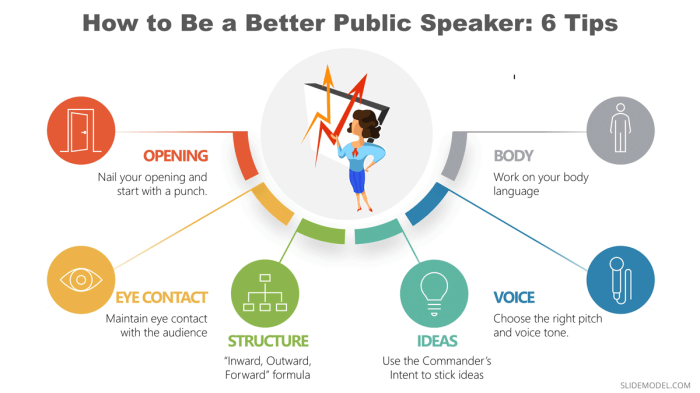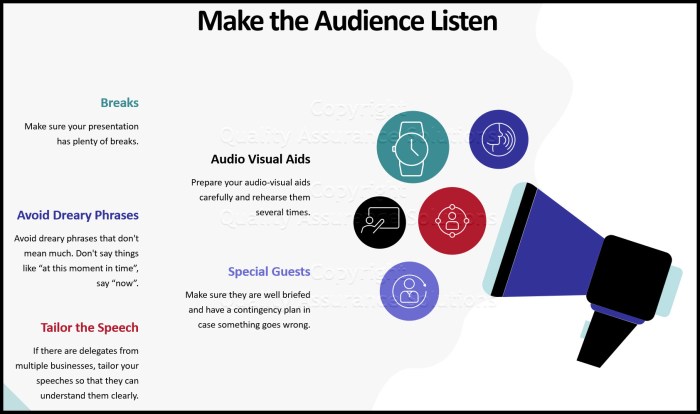Public Speaking Tips are essential for anyone looking to conquer their fears and captivate an audience with their words. From overcoming anxiety to mastering body language, this guide will help you shine on any stage.
Are you ready to unlock the secrets to effective public speaking? Let’s dive in!
Introduction to Public Speaking Tips
Public speaking is the art of communicating information to an audience in a clear and engaging manner. It is a crucial skill in various aspects of life, including professional settings, social interactions, and personal development. Being able to speak effectively in public can boost confidence, enhance career opportunities, and build strong relationships.
Benefits of Improving Public Speaking Skills
- Increased confidence: Improving public speaking skills can help individuals feel more self-assured and comfortable in various situations.
- Career advancement: Strong public speaking abilities can lead to better job prospects and promotions.
- Effective communication: Enhancing public speaking skills can improve overall communication abilities, both verbally and non-verbally.
- Building credibility: Being able to articulate ideas clearly can establish credibility and trust with others.
Common Challenges in Public Speaking
- Fear of public speaking: Many people experience anxiety or nervousness when speaking in front of others.
- Lack of preparation: Not adequately preparing for a speech can lead to confusion and lack of coherence.
- Poor body language: Body language plays a significant role in public speaking, and improper gestures or posture can detract from the message.
- Lack of engagement: Failing to connect with the audience can result in disinterest and lack of impact.
Overcoming Public Speaking Anxiety: Public Speaking Tips
Public speaking anxiety is a common fear that many people face, but there are strategies to help manage and reduce this anxiety.
Strategies to Manage and Reduce Anxiety
- Practice deep breathing exercises to calm your nerves before speaking.
- Visualize yourself giving a successful speech to boost your confidence.
- Prepare and practice your speech multiple times to feel more comfortable with the material.
- Focus on the message you want to deliver rather than your fear of speaking.
- Avoid caffeine and eat a light meal before your presentation to avoid additional stress.
Boosting Confidence Before Speaking
- Engage in power poses or positive affirmations to boost your confidence levels.
- Dress in an outfit that makes you feel confident and professional.
- Arrive early to the speaking venue to familiarize yourself with the space and set up.
- Interact with the audience before your speech to establish a connection and ease your nerves.
The Role of Practice in Overcoming Anxiety
- Rehearse your speech in front of a mirror or record yourself to identify areas for improvement.
- Practice speaking in front of friends or family to receive feedback and build confidence.
- Join a public speaking group or class to gain experience and overcome anxiety in a supportive environment.
- Embrace opportunities to speak in public to gradually desensitize yourself to the fear of public speaking.
Structuring a Speech

When it comes to delivering a successful speech, structuring your content is key to keeping your audience engaged and ensuring your message is effectively communicated. A well-structured speech consists of several key components that work together to create a clear and logical flow from start to finish.
Key Components of a Well-Structured Speech, Public Speaking Tips
- Introduction: Begin with a strong opening that captures the audience’s attention and introduces the topic.
- Main Points: Clearly Artikel the main points or arguments you will be discussing to provide structure and organization to your speech.
- Supporting Evidence: Back up your main points with relevant examples, statistics, stories, or other forms of evidence to strengthen your argument.
- Transitions: Smoothly transition between each main point to maintain a cohesive flow and keep your audience engaged.
- Conclusion: End your speech with a memorable conclusion that reinforces your main points and leaves a lasting impression on your audience.
Creating an Engaging Introduction and Conclusion
When crafting your introduction, consider using a compelling quote, asking a thought-provoking question, or sharing a relevant anecdote to draw in your audience from the start. Your conclusion should summarize your key points, reiterate your main message, and leave your audience with a lasting takeaway or call to action.
Importance of a Clear and Logical Flow in a Speech
A clear and logical flow in your speech is essential for keeping your audience engaged and ensuring they can follow your train of thought. By organizing your content in a structured manner, you make it easier for your audience to understand the information you are presenting and connect with your message on a deeper level.
Body Language and Delivery

Body language plays a crucial role in public speaking as it can enhance the message being delivered, convey confidence, and engage the audience. It includes facial expressions, posture, gestures, and eye contact.
Significance of Body Language
- Facial expressions can help convey emotions and emphasize key points in a speech.
- Posture is important as standing tall and straight can exude confidence and authority.
- Gestures can add emphasis to words and make the speech more dynamic.
- Eye contact establishes a connection with the audience and shows sincerity and confidence.
Improving Vocal Variety and Tone
- Practice varying your pitch, pace, and volume to keep the audience engaged.
- Use pauses strategically to emphasize important points and allow the audience to digest information.
- Work on your articulation and enunciation to ensure clarity in speech.
Impact of Eye Contact and Gestures
- Eye contact helps in building rapport with the audience and keeping them engaged.
- Gestures can make your speech more engaging and help in emphasizing key points.
- Avoid overusing gestures or making distracting movements that can take away from your message.
Handling Q&A Sessions
When it comes to handling questions from the audience, preparation is key. Be ready to address a variety of topics related to your speech and maintain a calm and composed demeanor throughout.
Strategies for Addressing Challenging Questions
Challenging questions can catch you off guard, but it’s essential to stay focused and composed. Here are some strategies to help you navigate through them:
- Take a deep breath and pause before responding to gather your thoughts.
- Repeat or rephrase the question to ensure you understand it correctly.
- Be honest if you don’t know the answer and offer to follow up with more information later.
- Acknowledge the questioner’s perspective and thank them for their input.
Importance of Active Listening
During Q&A sessions, active listening is crucial for providing meaningful responses. Here’s why it matters:
- Listening attentively shows respect to the audience and helps you address their concerns effectively.
- It allows you to tailor your responses based on the specific details provided in the questions.
- Active listening fosters a positive interaction with the audience and demonstrates your communication skills.